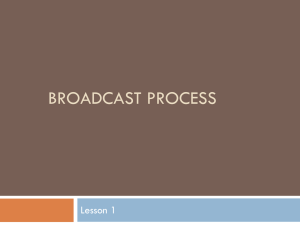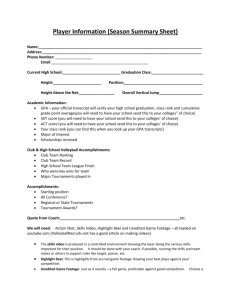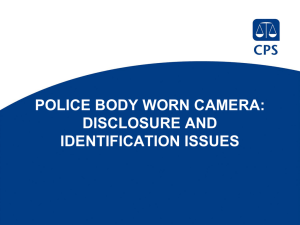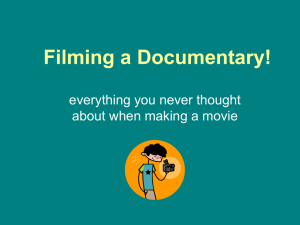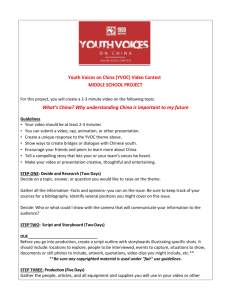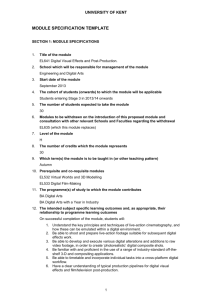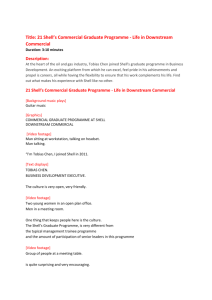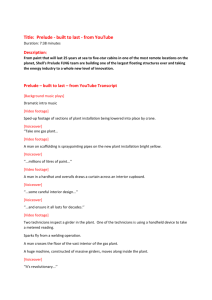Document
advertisement
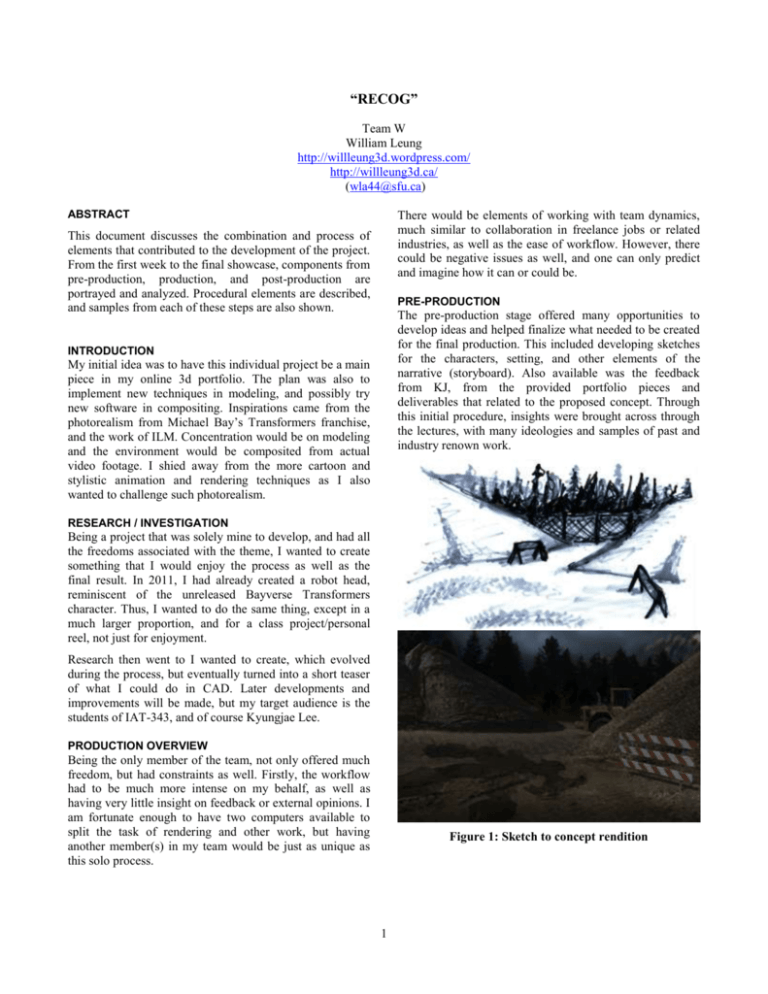
“RECOG” Team W William Leung http://willleung3d.wordpress.com/ http://willleung3d.ca/ (wla44@sfu.ca) ABSTRACT There would be elements of working with team dynamics, much similar to collaboration in freelance jobs or related industries, as well as the ease of workflow. However, there could be negative issues as well, and one can only predict and imagine how it can or could be. This document discusses the combination and process of elements that contributed to the development of the project. From the first week to the final showcase, components from pre-production, production, and post-production are portrayed and analyzed. Procedural elements are described, and samples from each of these steps are also shown. PRE-PRODUCTION The pre-production stage offered many opportunities to develop ideas and helped finalize what needed to be created for the final production. This included developing sketches for the characters, setting, and other elements of the narrative (storyboard). Also available was the feedback from KJ, from the provided portfolio pieces and deliverables that related to the proposed concept. Through this initial procedure, insights were brought across through the lectures, with many ideologies and samples of past and industry renown work. INTRODUCTION My initial idea was to have this individual project be a main piece in my online 3d portfolio. The plan was also to implement new techniques in modeling, and possibly try new software in compositing. Inspirations came from the photorealism from Michael Bay’s Transformers franchise, and the work of ILM. Concentration would be on modeling and the environment would be composited from actual video footage. I shied away from the more cartoon and stylistic animation and rendering techniques as I also wanted to challenge such photorealism. RESEARCH / INVESTIGATION Being a project that was solely mine to develop, and had all the freedoms associated with the theme, I wanted to create something that I would enjoy the process as well as the final result. In 2011, I had already created a robot head, reminiscent of the unreleased Bayverse Transformers character. Thus, I wanted to do the same thing, except in a much larger proportion, and for a class project/personal reel, not just for enjoyment. Research then went to I wanted to create, which evolved during the process, but eventually turned into a short teaser of what I could do in CAD. Later developments and improvements will be made, but my target audience is the students of IAT-343, and of course Kyungjae Lee. PRODUCTION OVERVIEW Being the only member of the team, not only offered much freedom, but had constraints as well. Firstly, the workflow had to be much more intense on my behalf, as well as having very little insight on feedback or external opinions. I am fortunate enough to have two computers available to split the task of rendering and other work, but having another member(s) in my team would be just as unique as this solo process. Figure 1: Sketch to concept rendition 1 PRODUCTION Modeling Modeling was a challenge, due to the references and chosen accuracy with both vehicles. Realism was a goal, and textures alongside a high detail model are necessary to pull of such a feat. the first portfolio, animation of the plane became evident that the level of realism had to be achieved. This meant the moving of the ailerons and stabilizers according to the way it is portrayed to the virtual camera. That being said, a lot of the shots were from an animated camera, simulating the motion of the plane, matted out to footage from the sky. The perspective here was quite intriguing to experiment with, from POV to dynamic shots. As for the vehicle, background images and footage were captured at my local gravel pit, and I was able to composite them with adequate shadows in CAD. This meant the freedom of having a stable camera, while part(s) of the vehicle could move individually. The problem here was the matching to the taken footage and camera angles, as constrained to the ground, it did not have the aerodynamic freedoms of the fighter jet. Lighting Figure 2: 1k+ model with high accuracy Texturing UVW unwrapping of many of the more organic models had to be done (F-18 Hornet jet), while because of the amount of singular elements of the other vehicle, I was able to texture them without large scale maps. The jet required the use of Adobe Photoshop to match different paneling from actual plane images to the fuselage, while the construction vehicle was more clean. Such created unwraps and textures were then applied to different materials for the model, named accordingly and organized, of course. I could have went for the standard daylight system setup, highly useful in simulating environments and daytime/night time lighting, but I choose a more traditional method. I once came across an interview discussing the daylight system being very similar to the older way of having a skylight coupled with a target light. This way I could control elements of each, being the colour of both emitted lights, types of shadows (raytraced), and the way shadows were projected. Rendering My main rendering engine was using Mentalray, though for some elements, I choose the reflective mapping qualities and presets from Solidworks. Rendering at 900x506 was not the most ideal as for most production work; at least 1600x900 or higher is adequate. However, time was the issue, as well as limited processing from CPU and NVidia Quadro with high poly counts; the resulting renders were ok for the scope of the project, and could be edited in post. This ensured the same aspect ratio as my camera footage, and gave consistence when editing Figure 3: Just some of the textures used Animating Animating the plane and construction robot was entirely different, because of the lack of personal footage from the gravel pit, versus up in the sky. From feedback received in Figure 4: Test render on ground footage POST-PRODUCTION Compositing Using the footage I took of the Lafarge Gravel Pit, I was able to create backgrounds and implement them in 3d. Doing so allowed the models to be positioned in a fashion that seemed reasonable to the angle and perspective of the taken image, and a ground plane could be created to catch shadows on. Similar to this would be of the external footage high above the clouds, which offered the freedom of matting out the background behind the plane, and later compositing the video footage of the sky instead. Figure 6: Flare used to simulate missile exhaust Figure 5: Main filming location Compositing all the renders into a single production piece was left to Adobe After Effects, as special effects would be needed. (See below). Figure 7: Particular trail effects DISCUSSION Sound Suggestion and improvements: Sound is an extremely importance aspect in conveying atmosphere, mood, and meaning in a video production. The project included a background track that had to highlight the visual elements, but not be conflicting with it. As I have no vocalizations or actual speaking characters, this idea of narration had to be brought forth by the audio choices. This included Jablonky’s music score from Transformers (2007), as well as related audio from an air force clip. Other robot sounds and relevant effects also were from such sci-fi movies. Do not use special effects in post but via 3d programs. Matchmaker implementation on footage. Gather actual footage and have proper camera setups. Provide own sound design and video footage. Create an even higher detailed model(s). Model and create transformation scheme for full robot. Cockpit and CGI pilot in CAD. Utilize other rendering engines like VRAY/IRAY. Special Effects Create and use grunge maps, specular maps, bump maps etc. Related to compositing the entirety of the reel, I used plugins from Adobe After Effects that could boost the visual quality of my footage. This included an abundance of my custom optical flares from Video Copilot, and missile trails from Trapcode Particular. These helped bump the sense of realism, as well as create the missile trails. Other than these, colour correction from Adobe Photoshop and After Effects were used to give the composition the right hue, as well as to colour burn a few areas that seemed too bright. Possibly make the environment(s) photorealistic in 3d. Paint and reference). create textures Work in a group workflow/rendering. 3 and from scratch (without stick to timeline for CONCLUSION http://www.adobe.com/ca/products/photoshop.html This project and its process gave me a great opportunity to learn and develop my very limited skillsets in 3d modeling. Though it is a passion of mine, creating the project alone not only presented many difficulties, but also showed myself firsthand, the importance of collaboration and the limits of a single, amateur individual. However, I am excited to have learnt the techniques that I implemented this semester, from the special effects in post-production, to the accurately moving pistons and hydraulics of my virtual Volvo front-loader. External: http://www.filmtracks.com/titles/transformers.html http://www.youtube.com/watch?v=T1A2GrvFJ1w http://www.showcase.ca/continuum/continuumphotos.aspx? s=Season+2+Episodics&e=Season+2,+Episode+1 http://www.imdb.com/title/tt1288558/ http://www.imdb.com/title/tt0418279/ REFERENCES Tutorial on Missiles: http://www.videocopilot.net/tutorial/smoke_trails/ Software: http://pixologic.com/ http://www.autodesk.com/products/autodesk-3dsmax/overview http://www.autodesk.com/products/autodeskmaya/overview http://www.redgiant.com/products/all/trapcode-particular/ http://www.adobe.com/ca/products/aftereffects.html https://www.videocopilot.net/products/opticalflares/ Filming Locations: http://www.yvr.ca/en/communityenvironment/community/community-engagement/PublicObservation-Area.aspx http://lafargehomedelivery.com/location/ http://www.topofvancouver.com/gallery.html TEAM BIOGRAPHY I am a 3d artist and visual designer extremely passionate in the visualization of ideas. My specialty is in 3d design and conceptualization, with skills in illustration, sculpting, modeling, texturing and lighting. Although, I am fluent in using CAD aided and digital media programs, I am not constrained to the platforms, and am very willing to try new techniques and experiences for designing.

